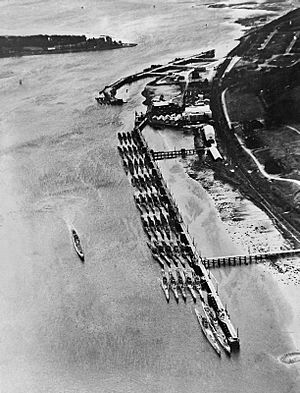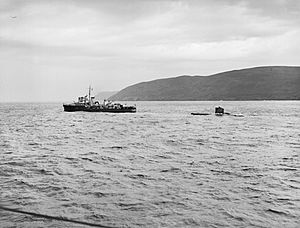Operation Deadlight facts for kids
Operation Deadlight was the name for a special plan by the Royal Navy (the British navy) right after World War II. From November 1945 to February 1946, they sank many German submarines, called U-boats. These U-boats had given up to the Allies after Germany lost the war. The goal was to make sure these powerful submarines could not be used again.
Sinking the U-boats
After World War II ended, 156 German U-boats surrendered to the Allies. Out of these, 116 were sunk as part of Operation Deadlight. The Royal Navy was in charge of this big job. They planned to pull the submarines to three different areas about 100 miles (160 km) northwest of Ireland.
Many of the U-boats were in bad shape. They had been waiting in busy harbors, and the weather was often very poor. Because of these problems, 56 U-boats sank on their way to the planned sinking areas. The submarines that did make it to the areas were usually sunk by gunfire from naval ships. It was too hard to use explosives in the rough seas.
The first U-boat was sunk on November 17, 1945. The very last one was sunk on February 11, 1946.
U-boats That Escaped
Not all U-boats were sunk during Operation Deadlight. Some were taken as prizes by countries like Britain, France, Norway, and the Soviet Union.
Four U-boats were in East Asia when Germany surrendered. Japan took control of these. For example, U-181 became I-501, and U-862 became I-502. Two other U-boats, U-511 and U-1224, had already been sold to Japan in 1943. They were renamed RO-500 and RO-501.
Two U-boats that survived Operation Deadlight are now museum ships.
- U-505: This U-boat was supposed to be sunk. However, an American admiral named Daniel V. Gallery successfully argued that it should not be. His team had captured U-505 during a battle in 1944. Since it was captured, not surrendered, it was saved. Today, U-505 is a war memorial at the Museum of Science and Industry in Chicago.
- U-995: Britain gave this U-boat to Norway in 1948, and it was renamed Kaura. In 1965, it was returned to Germany. Since October 1971, U-995 has been a museum ship at Laboe.
Searching for Sunken U-boats
In the early 2000s, a special underwater explorer named Innes McCartney found and studied fourteen of the U-boat wrecks. Among them was a rare Type XXI U-boat called U-2506. He also found the successful Type IXC U-boat, U-155, and U-778, which looked like it might be possible to bring to the surface.
In 2007, the local council in Derry City announced plans to raise U-778. They wanted it to be the main display in a new museum about the sea. However, in November 2009, the project was canceled because it was too expensive.
See also
- List of Operation Deadlight U-boats
- HMS Ferret (1940 shore establishment)
- Scuttling of the German fleet at Scapa Flow



